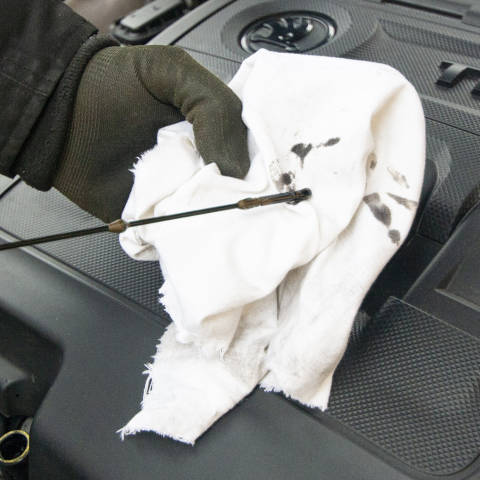Check Your Car Oil Regularly
Oil is the blood for automobiles. Changing your engine oil on a regular basis prolongs your engine's life. You should check your oil on a monthly basis, but more often if you know that your car burns oil.
To check your oil, make sure you are parked on a flat surface like a parking lot rather than in your driveway in order to get an accurate oil level reading.
Oil color should be light brown and clean. If the oil comes out dark brown or black, or has small pieces of dirt, it's time for an oil and oil filter change. The oil filter captures the dirt particles and debris and keeps your engine running smooth.
If your engine has a lot of dirt and debris and/or is burning oil, it may need to get a good engine flush and optionally a engine fluid treatment that will tighten the seals around the pistons.
If the level is below full, add some oil, then wait a few minutes before checking again to allow the oil to flow down to the bottom of the engine. You should change your oil every 5,000 km or every 3 months if your car uses regular oil and every 10,000 km or every 6 months if your car uses synthetic oil.

Signs it is Time for an Oil Change
Below are some of the signs you should watch out for when checking your oil to know if it's time for an oil change:
- The oil looks dark or black
- There is debris in the oil
- Check engine oil light is on
- It's been past the recommended time to check your oil
- You hear clanging noises coming from the engine
If you hear clanging noises coming from the engine, ensure your oil is topped off before coming in for a change. Your car will make clanging noises when there is not enough oil in the engine.
You may have heard your engine make clanging noises when you turn the car on in the winter and it's below -25°C. In these cold conditions, the engine oil is very thick and it takes a little bit of time for the oil to warm up and lubricate the engine. In these cases, we recommend you warm up the engine for a few minutes before driving. When it's only -10°C, warming up the engine for minute or two will be enough.
Oil Types
There are different types of oil for different purposes. The most common engine oils are 5W30 and 10W30. The difference between them is their viscosity or thickness/flow. The 5 and 10 refer to the oil viscosity at lower temperatures. The lower the number the better the oil flows, the higher the number, the thicker the oil. So which oil should you use? Since 5W30 flows easier, it's better to use in the cold Canadian winter, while in the hot summers, 10W30 will be the better choice.
Synthetic Oil vs. Regular Oil
Conventional oil is just the most basic oil that you can get for your car. Synthetic oil traditionally was used for high performance engines but has recently become common to use for regular engines due to the increasingly higher technologies used in today's engines. Synthetic oil is more stable at higher temperatures and more fluid at lower temperatures which keeps the engine in top shape.
Also common these days are oils called "Synthetic Blends". These are just as the name says, a blend of oils that offer some benefits but don't break your wallet.